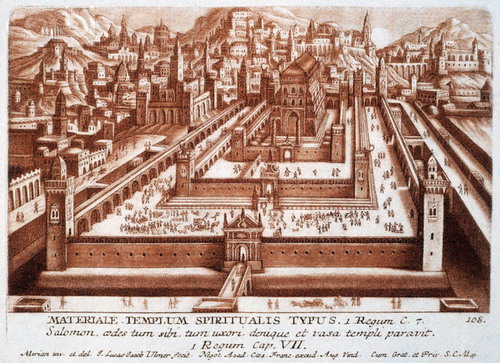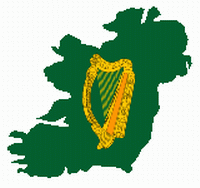The First Book of Kings
The First Book of Kings
Chapter Seven
1-Kings 7
The Palace of Solomon and Temple Utensils
1-Kings 7
[1-Kings 7:1] BUT SOLOMON WAS BUILDING
HIS OWN HOUSE THIRTEEN YEARS, AND HE FINISHED ALL HIS HOUSE.
Daat Mikra understands from various verses concerning the Monarchical
residence that it was close to the Temple Mount but lower down from it though
elevated above the "City of David". It seems to have been understood that the
Place of Solomon was adjacent to the Temple Mount.
[1-Kings 7:2] HE BUILT ALSO THE HOUSE OF
THE FOREST OF LEBANON; THE LENGTH THEREOF WAS AN HUNDRED CUBITS, AND THE
BREADTH THEREOF FIFTY CUBITS, AND THE HEIGHT THEREOF THIRTY CUBITS, UPON FOUR
ROWS OF CEDAR PILLARS, WITH CEDAR BEAMS UPON THE PILLARS.
##HE BUILT ALSO##. This seems like a mistranslation. "Also" should not be there.
THE HOUSE OF THE FOREST OF LEBANON is another name for the House of Solomon. The
wood was brought from the Forests of Lebanon.
The gold may have come from South Africa.
Some of it probably also came from Ireland which in the Bronze Age was a source
of gold.
Ireland was also a source of copper which would be mined then alloyed with tin
brought over from Conrwall to make bronze which would then be exported.
Bronze implements found on the site of Dan in Northern Israel were analyzed. The
tin used in the bronze was found to contain traces of gold indicating (according
to the excavator of Tell Dan, Dr. Avraham Biran) a possible origin from
Cornwall.
Welsh Gold
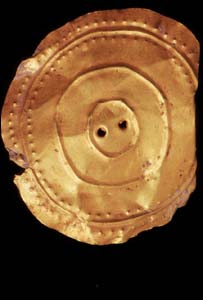
|
Irish Gold

|
British Gold
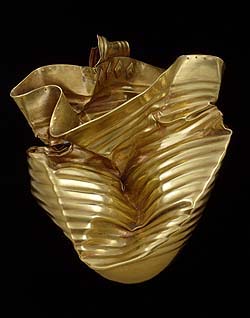
|
The tin used in the manufacture of bronze in the region of Israel came from both
Britain and Africa:
See our notes on Tarshish:
http://britam.org/Questions/QuesTarshish.html
Africa (Uganda) was also a source of tin:
"Central Africa as a Source of Tin" by John E. Dayton item #163
"Recent lead isotope analysis of lead
ingots found in Haifa in 1982 have thrown new light on possible sources of
Bronze Age tin. The analyses of
Bergernanli show that some of the
Haifa tin came from the extensive tin fields of Central Africa".
cf. also:
"From the Red to the Med" by Harry Bourne, 2003:
" John Taylor (Oxford Journal of
Archaeology 1988) noted the closeness of dates for the Voyage of
Hanno
and that for the oldest workings for Nigerian tin. Both Dayton and Taylor
attribute this tin-trade to Phoenicians."
Bourne gives additional evidence for the presence of Phoenicians in East Africa.
This includes Phoenician shipwrecks reportedly found in Mozambique and Tanzania.
Phoenician type dogs and cats are found in Madagascar. Phoenician jewellery was
depicted by Egyptians on the leg of the African King of Punt. Phoenician
shipbuilders and sailors were in Egyptian service along the African coast. The
Old-Egyptian word for sea ("ym") is of Phoenician origin. The Egyptian contacts
with East Africa were dependent on Phoenician seafaring. The
originally-Phoenician trident-symbol of Poseidon is noted in East and West
Africa and other signs of Phoenician influence exist. The Carthaginians who were
of Phoenician descent also maintained contacts with West Africa.
[1-Kings 7:3] AND IT WAS COVERED WITH
CEDAR ABOVE UPON THE BEAMS, THAT LAY ON FORTY FIVE PILLARS, FIFTEEN IN A ROW.
This whole description of the House of Solomon must be important and
possibly has great symbolic value.
I myself however am not really interested in the subject and have difficulty
following the account.
See below illustrations of the House of Solomon that may be of use to
understanding these passages.
http://news.duke.edu/2008/07/goldstein.html
http://pro.corbis.com/search/Enlargement.aspx?CID=isg&mediauid=%7B1CA67A29-7142-40BB-89F9-A3984B9C5D21%7D
Source: Shalom Dov Steinberg, "Tsurat Beit HaMikdash HaRishon", Jerusalem, 5755
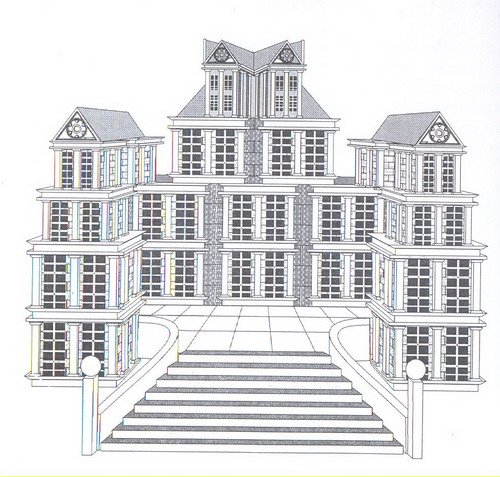
|
[1-Kings 7:4] AND THERE WERE WINDOWS IN
THREE ROWS, AND LIGHT WAS AGAINST LIGHT IN THREE RANKS.
[1-Kings 7:5] AND ALL THE DOORS AND
POSTS WERE SQUARE, WITH THE WINDOWS: AND LIGHT WAS AGAINST LIGHT IN THREE
RANKS.
[1-Kings 7:6] AND HE MADE A PORCH OF
PILLARS; THE LENGTH THEREOF WAS FIFTY CUBITS, AND THE BREADTH THEREOF THIRTY
CUBITS: AND THE PORCH WAS BEFORE THEM: AND THE OTHER PILLARS AND THE THICK BEAM
WERE BEFORE THEM.
[1-Kings 7:7] THEN HE MADE A PORCH FOR
THE THRONE WHERE HE MIGHT JUDGE, EVEN THE PORCH OF JUDGMENT: AND IT WAS COVERED
WITH CEDAR FROM ONE SIDE OF THE FLOOR TO THE OTHER.
[1-Kings 7:8] AND HIS HOUSE WHERE HE
DWELT HAD ANOTHER COURT WITHIN THE PORCH, WHICH WAS OF THE LIKE WORK. SOLOMON
MADE ALSO AN HOUSE FOR PHARAOH'S DAUGHTER, WHOM HE HAD TAKEN TO WIFE, LIKE UNTO
THIS PORCH.
Solomon had three hundred regular wives and 700 concubines. Nevertheless
the daughter of Pharoah is the one Scripture keeps referring to. The sages said
that in the eyes of Solomon "the daughter of Pharoah" was more important than
all the others.
[1-Kings 7:9] ALL THESE WERE OF COSTLY
STONES, ACCORDING TO THE MEASURES OF HEWED STONES, SAWED WITH SAWS, WITHIN AND
WITHOUT, EVEN FROM THE FOUNDATION UNTO THE COPING, AND SO ON THE OUTSIDE TOWARD
THE GREAT COURT.
[1-Kings 7:10] AND THE FOUNDATION WAS OF
COSTLY STONES, EVEN GREAT STONES, STONES OF TEN CUBITS, AND STONES OF EIGHT
CUBITS.
[1-Kings 7:11] AND ABOVE WERE COSTLY
STONES, AFTER THE MEASURES OF HEWED STONES, AND CEDARS.
[1-Kings 7:12] AND THE GREAT COURT ROUND
ABOUT WAS WITH THREE ROWS OF HEWED STONES, AND A ROW OF CEDAR BEAMS, BOTH FOR
THE INNER COURT OF THE HOUSE OF THE LORD, AND FOR THE PORCH OF THE HOUSE.
[1-Kings 7:13] AND KING SOLOMON SENT AND
FETCHED HIRAM OUT OF TYRE.
[1-Kings 7:14] HE WAS A WIDOW'S SON OF
THE TRIBE OF NAPHTALI,
AND HIS FATHER WAS A MAN OF TYRE,
A WORKER IN BRASS: AND HE WAS FILLED WITH WISDOM, AND UNDERSTANDING, AND CUNNING
TO WORK ALL WORKS IN BRASS. AND HE CAME TO KING SOLOMON, AND WROUGHT ALL HIS
WORK.
His mother came from Dan (2-Chronicles 2:13) and his father (an inhabitant of
Tyre) from Naphtali. Tyre was a Phoenician city but in the territory of the
Israelite Tribe of Asher. Israelites by the time of Solomon had intermixed with
the Phoenicians and shared their culture as well as contributing towards
it.
[1-Kings 7:15] FOR HE CAST TWO PILLARS
OF BRASS, OF EIGHTEEN CUBITS HIGH APIECE: AND A LINE OF TWELVE CUBITS DID
COMPASS EITHER OF THEM ABOUT.
The account now leaves the building of the Palace of Solomon and returns to the
Temple.
These pillars were part of the Temple.
[1-Kings 7:16] AND HE MADE TWO
CHAPITERS
OF MOLTEN BRASS, TO SET UPON THE TOPS OF THE PILLARS: THE HEIGHT OF THE ONE
CHAPITER
WAS FIVE CUBITS, AND THE HEIGHT OF THE OTHER
CHAPITER
WAS FIVE CUBITS:
CHAPITERS. Hebrew "coterot" or "headings", i.e. capitals.
[1-Kings 7:17] AND NETS OF CHECKER WORK, AND WREATHS OF CHAIN WORK, FOR THE CHAPITERS
WHICH WERE UPON THE TOP OF THE PILLARS; SEVEN FOR THE ONE CHAPITER, AND SEVEN
FOR THE OTHER CHAPITER.
[1-Kings 7:18] AND HE MADE THE PILLARS,
AND TWO ROWS ROUND ABOUT UPON THE ONE NETWORK, TO COVER THE
CHAPITERS
THAT WERE UPON THE TOP, WITH POMEGRANATES: AND SO DID HE FOR THE OTHER
CHAPITER.
[1-Kings 7:19] AND THE
CHAPITERS
THAT WERE UPON THE TOP OF THE PILLARS WERE OF LILY WORK IN THE PORCH, FOUR
CUBITS.
[1-Kings 7:20] AND THE
CHAPITERS
UPON THE TWO PILLARS HAD POMEGRANATES ALSO ABOVE, OVER AGAINST THE BELLY WHICH
WAS BY THE NETWORK: AND THE POMEGRANATES WERE TWO HUNDRED IN ROWS ROUND ABOUT
UPON THE OTHER CHAPITER.
[1-Kings 7:21] AND HE SET UP THE PILLARS
IN THE PORCH OF THE TEMPLE: AND HE SET UP THE RIGHT PILLAR, AND CALLED THE NAME
THEREOF JACHIN:
AND HE SET UP THE LEFT PILLAR, AND CALLED THE NAME THEREOF BOAZ.
[1-Kings 7:22] AND UPON THE TOP OF THE
PILLARS WAS LILY WORK: SO WAS THE WORK OF THE PILLARS FINISHED.
[1-Kings 7:23] AND HE MADE A MOLTEN SEA,
TEN CUBITS FROM THE ONE BRIM TO THE OTHER: IT WAS ROUND ALL ABOUT, AND HIS
HEIGHT WAS FIVE CUBITS: AND A LINE OF THIRTY CUBITS DID COMPASS IT ROUND ABOUT.
This was a giant basin.
[1-Kings 7:24] AND UNDER THE BRIM OF IT
ROUND ABOUT THERE WERE KNOPS COMPASSING IT, TEN IN A CUBIT, COMPASSING THE SEA
ROUND ABOUT: THE KNOPS WERE CAST IN TWO ROWS, WHEN IT WAS CAST.
[1-Kings 7:25] IT STOOD UPON TWELVE
OXEN, THREE LOOKING TOWARD THE NORTH, AND THREE LOOKING TOWARD THE WEST, AND
THREE LOOKING TOWARD THE SOUTH, AND THREE LOOKING TOWARD THE EAST: AND THE SEA
WAS SET ABOVE UPON THEM, AND ALL THEIR HINDER PARTS WERE INWARD.
[1-Kings 7:26] AND IT WAS AN HAND
BREADTH THICK, AND THE BRIM THEREOF WAS WROUGHT LIKE THE BRIM OF A CUP, WITH
FLOWERS OF LILIES: IT CONTAINED TWO THOUSAND BATHS.
#BATHS#. "Bat" or "bath" in Biblical Hebrew was a liquid measurement.
This may be where the English words "bathe" and "bath" come from.
[1-Kings 7:27] AND HE MADE TEN BASES OF
BRASS; FOUR CUBITS WAS THE LENGTH OF ONE BASE, AND FOUR CUBITS THE BREADTH
THEREOF, AND THREE CUBITS THE HEIGHT OF IT.
These "bases of brass" were frameworks on which basins were set.
The word translated as "brass" in Hebrew is "nechoshet".
Literally speaking "nechoshet" means "copper". Here it is understand to mean
"bronze" which is an alloy of "tin and copper".
"brass" is an alloy of zinc and copper.
[1-Kings 7:28] AND THE WORK OF THE BASES
WAS ON THIS MANNER: THEY HAD BORDERS, AND THE BORDERS WERE BETWEEN THE
LEDGES:
[1-Kings 7:29] AND ON THE BORDERS THAT
WERE BETWEEN THE LEDGES WERE LIONS, OXEN, AND
CHERUBIMS:
AND UPON THE LEDGES THERE WAS A BASE ABOVE: AND BENEATH THE LIONS AND OXEN WERE
CERTAIN ADDITIONS MADE OF THIN WORK.
[1-Kings 7:30] AND EVERY BASE HAD FOUR
BRASEN
WHEELS, AND PLATES OF BRASS: AND THE FOUR CORNERS THEREOF HAD
UNDERSETTERS:
UNDER THE LAVER WERE UNDERSETTERS
MOLTEN, AT THE SIDE OF EVERY ADDITION.
[1-Kings 7:31] AND THE MOUTH OF IT
WITHIN THE CHAPITER
AND ABOVE WAS A CUBIT: BUT THE MOUTH THEREOF WAS ROUND AFTER THE WORK OF THE
BASE, A CUBIT AND AN HALF: AND ALSO UPON THE MOUTH OF IT WERE
GRAVINGS
WITH THEIR BORDERS, FOURSQUARE, NOT ROUND.
[1-Kings 7:32] AND UNDER THE BORDERS
WERE FOUR WHEELS; AND THE AXLETREES OF THE WHEELS WERE JOINED TO THE BASE: AND
THE HEIGHT OF A WHEEL WAS A CUBIT AND HALF A CUBIT.
[1-Kings 7:33] AND THE WORK OF THE
WHEELS WAS LIKE THE WORK OF A CHARIOT WHEEL: THEIR AXLETREES, AND THEIR NAVES,
AND THEIR FELLOES, AND THEIR SPOKES, WERE ALL MOLTEN.
[1-Kings 7:34] AND THERE WERE FOUR
UNDERSETTERS
TO THE FOUR CORNERS OF ONE BASE: AND THE
UNDERSETTERS
WERE OF THE VERY BASE ITSELF.
[1-Kings 7:35] AND IN THE TOP OF THE
BASE WAS THERE A ROUND COMPASS OF HALF A CUBIT HIGH: AND ON THE TOP OF THE BASE
THE LEDGES THEREOF AND THE BORDERS THEREOF WERE OF THE SAME.
[1-Kings 7:36] FOR ON THE PLATES OF THE
LEDGES THEREOF, AND ON THE BORDERS THEREOF, HE GRAVED
CHERUBIMS,
LIONS, AND PALM TREES, ACCORDING TO THE PROPORTION OF EVERY ONE, AND ADDITIONS
ROUND ABOUT.
[1-Kings 7:37] AFTER THIS MANNER HE MADE
THE TEN BASES: ALL OF THEM HAD ONE CASTING, ONE MEASURE, AND ONE
SIZE.
[1-Kings 7:38] THEN MADE HE TEN LAVERS
OF BRASS: ONE LAVER CONTAINED FORTY BATHS: AND EVERY LAVER WAS FOUR CUBITS: AND
UPON EVERY ONE OF THE TEN BASES ONE LAVER.
[1-Kings 7:39] AND HE PUT FIVE BASES ON
THE RIGHT SIDE OF THE HOUSE, AND FIVE ON THE LEFT SIDE OF THE HOUSE: AND HE SET
THE SEA ON THE RIGHT SIDE OF THE HOUSE EASTWARD OVER AGAINST THE
SOUTH.
[1-Kings 7:40] AND HIRAM MADE THE
LAVERS, AND THE SHOVELS, AND THE
BASONS. SO HIRAM MADE AN END OF
DOING ALL THE WORK THAT HE MADE KING SOLOMON FOR THE HOUSE OF THE
LORD:
[1-Kings 7:41] THE TWO PILLARS, AND THE
TWO BOWLS OF THE CHAPITERS
THAT WERE ON THE TOP OF THE TWO PILLARS; AND THE TWO NETWORKS, TO COVER THE TWO
BOWLS OF THE CHAPITERS
WHICH WERE UPON THE TOP OF THE PILLARS;
[1-Kings 7:42] AND FOUR HUNDRED
POMEGRANATES FOR THE TWO NETWORKS, EVEN TWO ROWS OF POMEGRANATES FOR ONE
NETWORK, TO COVER THE TWO BOWLS OF THE
CHAPITERS
THAT WERE UPON THE PILLARS;
[1-Kings 7:43] AND THE TEN BASES, AND
TEN LAVERS ON THE BASES;
[1-Kings 7:44] AND ONE SEA, AND TWELVE
OXEN UNDER THE SEA;
[1-Kings 7:45] AND THE POTS, AND THE
SHOVELS, AND THE BASONS:
AND ALL THESE VESSELS, WHICH HIRAM MADE TO KING SOLOMON FOR THE HOUSE OF THE
LORD, WERE OF BRIGHT BRASS.
[1-Kings 7:46] IN THE PLAIN OF JORDAN
DID THE KING CAST THEM, IN THE CLAY GROUND BETWEEN SUCCOTH AND
ZARTHAN.
This area is just east of the Jordan River in a valley where the local clay is
of a high quality for the making of utensils and casts for the formation of
metal implements.
This was a metallurgical center for the working of bronze associated with the
"Sea-Peoples". It was in the territory of Gad.
An inscription has been found in this region that speaks of Balaam and Netser.
We analyze the text of this inscription in our work, "Ephraim. The Gentile
Children of Israel".
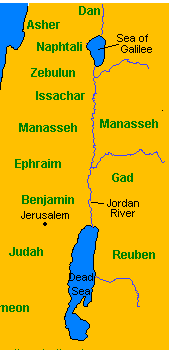
|
Irish Gold
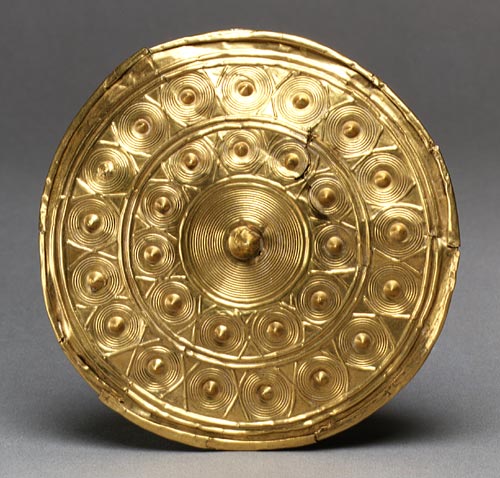
|
[1-Kings 7:47] AND SOLOMON LEFT ALL THE
VESSELS UNWEIGHED,
BECAUSE THEY WERE EXCEEDING MANY: NEITHER WAS THE WEIGHT OF THE BRASS FOUND
OUT.
[1-Kings 7:48] AND SOLOMON MADE ALL THE
VESSELS THAT PERTAINED UNTO THE HOUSE OF THE LORD: THE ALTAR OF GOLD, AND THE
TABLE OF GOLD, WHEREUPON THE
SHEWBREAD WAS,
[1-Kings 7:49] AND THE CANDLESTICKS OF
PURE GOLD, FIVE ON THE RIGHT SIDE, AND FIVE ON THE LEFT, BEFORE THE ORACLE,
WITH THE FLOWERS, AND THE LAMPS, AND THE TONGS OF GOLD,
[1-Kings 7:50] AND THE BOWLS, AND THE
SNUFFERS, AND THE BASONS,
AND THE SPOONS, AND THE CENSERS OF PURE GOLD; AND THE HINGES OF GOLD, BOTH FOR
THE DOORS OF THE INNER HOUSE, THE MOST HOLY PLACE, AND FOR THE DOORS OF THE
HOUSE, TO WIT, OF THE TEMPLE.
[1-Kings 7:51] SO WAS ENDED ALL THE WORK
THAT KING SOLOMON MADE FOR THE HOUSE OF THE LORD. AND SOLOMON BROUGHT IN THE
THINGS WHICH DAVID HIS FATHER HAD DEDICATED; EVEN THE SILVER, AND THE GOLD, AND
THE VESSELS, DID HE PUT AMONG THE TREASURES OF THE HOUSE OF THE
LORD.




